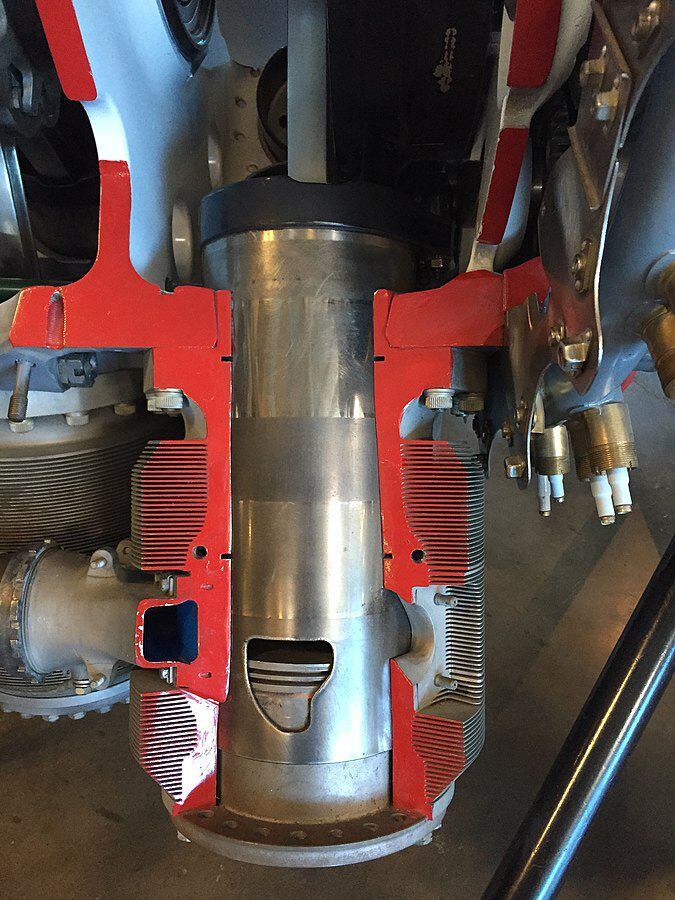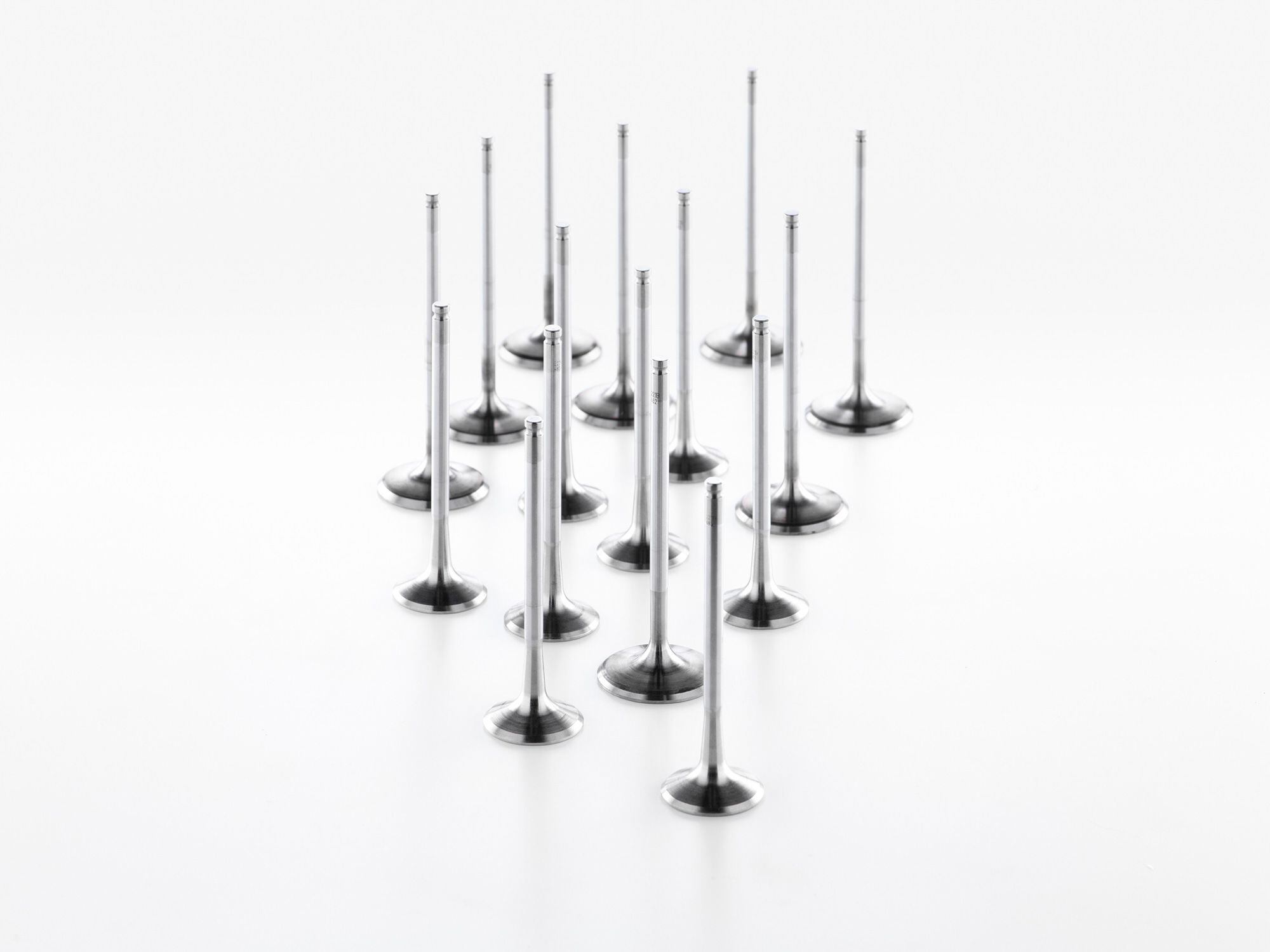
 |
|
|
#1 |
|
All the news that's fit to excerpt
Name: newsie
Location: who knows?
Join Date: Jun 2008 Motorcycle(s): only digital replicas Posts: Too much.
|
[cycleworld.com] - How the Poppet Valve Won Its Place in Internal Combustion
The simple poppet valve is an integral part to the success of motorcycling. Kevin Cameron explains.
Click here to view on their site.  Kevin Cameron has been writing about motorcycles for nearly 50 years, first for Cycle magazine and, since 1992, for Cycle World. (Robert Martin/)Early internal combustion engines were very much influenced by steam technology. The usual industrial steam engine had a horizontal cylinder driving a single-throw crankshaft carrying two big flywheels. For many years, the valves controlling the flow of steam into and out of the cylinder were slide valves driven by simple eccentrics. Their reciprocating motion uncovered and covered ports that admitted or released steam. Limitations of Sliding Valves Improving steam engine efficiency required ever-higher steam temperature and pressure. Soon the limited ability of available steam oils to prevent rapid wear or scoring of slide valves became a problem. A type of valve free of sliding contact was required—something rather like a sink stopper operated remotely by a central rod. The edge of the circular “stopper” was cut at roughly 45 degrees to make it self-centering and its central rod—the valve stem—worked back and forth in a closely fitting valve guide. Valve operating mechanism pushed on the end of the valve stem, lifting the circular valve head off its seat. A spring kept the valve firmly seated when closed. During the high-pressure part of the engine cycle such a valve would be closed and motionless, eliminating friction. High Exhaust Gas Temperature The exhaust gas temperature of early IC engines was very high because their low compression ratios converted so little of the combustion gas energy into mechanical work. Steels gave up so easily in such heat that two-piece valves were tried with cast-iron heads and steel stems (they make stoves out of cast iron, right?). Other experimenters tried to water-cool valves—with sometimes explosive results. The development of cutting tool materials in the late 19th century, able to retain their hardness at red heat, led to mass production from about 1910 and a revolution in metal-cutting. Such 8 percent tungsten, 3 percent chromium “high speed steels” were soon tried as exhaust valves. Another approach to the problem was to use the engine’s intake air to cool the valve. This was done by having a single valve perform both intake and exhaust functions, with a “Y-valve” upstream from it that alternately connected the port to intake or exhaust. During the homicidal years of World War I, German liquid-cooled aircraft engines were designed such that the middle part of each exhaust valve guide was directly exposed to engine cooling water. What modern-day Detroit hails as “strategic cooling”—positioning little nozzles inside the engine’s cylinder head to direct the coolest water, fresh from passing through the radiator, right onto material adjacent to exhaust valve seats and guides, also originated during WWI. Human ingenuity is like gravity—it never lets up. Grinding the Valves The poppet valve’s susceptibility to high temperature corrosion required frequent maintenance. This took the form of “grinding the valves” (using an abrasive compound between valve and seat and rotating the valve back and forth to grind them into smooth and intimate contact). Engine operation gradually caused pitting and erosion of valve sealing faces and seats, leading to leakage and loss of compression, and tireless mechanics would periodically restore good sealing by “grinding the valves.” Because with early valve materials this had to be done every few weeks, the chauffeurs of wealthy owners were factory trained to perform this and other maintenance operations to keep cars ready for service. Stainless Steels Appear A more corrosion-resistant poppet valve material came along in the 1920s—stainless steels consisting of iron alloyed with a hefty percentage of chromium plus a lesser amount of nickel. Additions of chromium above 10.5 percent result in the formation of a highly corrosion-resistant surface layer of chromium oxide that is self-healing. Adding roughly 8 percent nickel allows the alloy to remain in austenitic form (iron’s natural state when very hot) and provides workability and ductility. You may have seen stainless kitchenware bearing the label “18/8 stainless.” This has long been an alloy for food service, containing 18 percent Cr and 8 percent Ni. Alternatives to the Poppet Valve The poppet valve had competition in the form of sleeve valve or rotary valve schemes. The initial motivation for this was the annoying clicking of poppet valve operating mechanism—cams and tappets. The clicking existed because there had to be some clearance in the valve drive to allow for the heat expansion of the valves themselves. If the valve train were silenced by setting clearance between the parts at zero, valve expansion as the engine warmed up would destroy the valves’ seal by holding them slightly open. In modern automobile engines, self-adjusting hydraulic tappets actively maintain this clearance at zero, but before their widespread use valve clatter was a feature of motoring. Related: The Five-Angle Valve Job  Sleeve valve in a Bristol Centaurus aircraft engine. (Kitplane01, CC BY-SA 4.0, via Wikimedia Commons/)In early days the Knight double sleeve valve conferred silent operation. Two sleeves, one fitting closely inside the other, and the outer sleeve fitting closely in the engine’s cylinder bore, were worked by small cranks and con-rods, operating at one-half crankshaft speed. One sleeve was ported to control the intake function, the other to valve the exhaust. Because the specific power of engines was quite low at the time, heating of the exhaust sleeve by hot gas was kept under control by the constant sliding motion of the sleeves, heat being transmitted fairly well across their oil films. Later, the Burt-McCollum single sleeve valve offered a simplified mechanism. Instead of being driven back and forth, the single sleeve was driven such that any point on its surface described a circular motion. Intake and exhaust ports in the cylinder wall were situated to line up with similar ports in the sleeve to perform the four-stroke cycle of intake, compression, power, and exhaust. Tough Conditions for Poppet Valves—Large Aircraft Engines As aircraft piston engines were developed in ever-larger sizes through the 1920s and ‘30s, cylinders became as large as 200ci each, served by very large valves whose size (as big as 3-1/4 inches head diameter) made them very difficult to cool. Most of a valve’s cooling takes place through its seat, although some heat does move up the stem. As a result, the point of greatest temperature is between the two—right where the stem begins to flare to form the valve head. It was here that many an aircraft engine exhaust valve broke in two, usually causing an engine wreck. Valve operating temperature was so important to reliability in early days that it was common to pull a pipe off as an engine ran on the dyno to look up the port. “Running black” was ideal but exhaust valve failure was one of the top four causes of motorcycle DNFs at Britain’s great Brooklands Speedway (belt slippage and valve failure topped the list, followed by spark plugs and tires). Engineers continued to seek alternatives to the poppet valve, in hope of eliminating the hot valve from the combustion chamber. The resulting cooler combustion chamber gave greater resistance to detonation, allowing safe use of either increased compression ratio or higher supercharger boost. Rotary Valves Tried in Motorcycle Engines Two ideas tested by motorcycle manufacturers in the 1930s were the Cross and Aspin rotary valves, both located in the cylinder head. Prototype engines employing these ideas were built in hope of Isle of Man success, but neither Velocette’s time-consuming Aspin project nor a Norton try of the Cross valve equaled the power of those makers’ poppet-valve engines. As you can imagine, sealing rotating valves and keeping them seizure-free required amounts of oil that threatened to foul spark plugs. Norton in the 1950s tested a Manx-based 500 with a Cross rotary valve that produced competitive power, but demonstrated no real advantage. Walter Froede, one of the engineers behind the German NSU’s 1953–54 dominance of 125 and 250 GP roadracing, had during the war developed a disc rotary valve system whose purpose was to make a Naval torpedo engine more compact than was possible with overhead poppet valves. NSU’s racing engines employed conventional poppet valves driven by DOHC. In recent decades there have also been whisperings of rotary valve experiments by F1 teams, none of which has seen the light of day. Such experiments were surely driven by the proposition that “If it’s possible to seal up a Wankel engine, it ought to be easy to seal a rotary valve system.” Again, only rumors, no results. Internal Liquid-Cooling of Valves Valve coolants other than water were evaluated between the wars, with mercury as a first choice. Just the valve’s stem was made hollow at first, partly filled with the liquid metal such that its motion up and down the stem as the valve performed its cycle would tend to equalize temperatures along the valve’s length. Next try was salt-cooling (molten salts of various chemistry had for years been used in heat-treatment). The most effective investigator was air cooling pioneer S.D. Heron, who eventually hit upon sodium as the best valve internal coolant. Literally millions of such valves were produced for aircraft piston engines in WWII, continuing into the late 1950s. Sleeve vs. Poppet In 1920s Britain, IC engine pioneer Harry Ricardo was singing the praises of the single sleeve valve. The reason? There was no superhot exhaust valve in the combustion chamber, heating the entering fresh charge and pushing it toward the dreaded detonation. Both Bristol and Napier produced thousands of high-power sleeve-valve engines for WWII warplanes. Despite that, the poppet-valve engine was saved by two inventions: Heron’s internally cooled exhaust valve with hollow stem and head, and Delco employee Thomas Midgley’s discovery of the powerful anti-detonant effect of tetraethyl lead as a fuel additive. Poppet-valve advocates (apologists?) insist to this day that the sleeve valve’s complexity was superfluous because the two inventions above added up to poppet valve engines at least as powerful and reliable as the best sleeve valvers. Sodium-filled exhaust valves have also seen long service in heavy-duty truck engines and some hi-po auto engines as well. Motorcycle Exhaust Valve Problems The life of an exhaust valve can be hard even in the smaller sizes fitted to motorcycle engines. Norton had so much trouble with exhaust valves (even when sodium-filled) in their air-cooled single-cylinder 500 Manx race engines that in 1953 they were provided with a spiral passage around the exhaust valve guide, through which liquid was circulated to a small cooler affixed to the right-hand downtube. Designed for AJS by Ike Hatch was the celebrated three-valve 7R variant, the 7R3. Although present-day three-valvers are built with two inlets and a single exhaust, Hatch gave the 7R3 two smaller exhaust valves and a single intake. His reasons were twofold:
 Poppet valves are essentially ubiquitous in modern engines. (Ducati/)The Two-Stroke Interlude Two-stroke engines occupied a sizable part of the US motorcycle market 1965–84. In such simple crankcase-scavenged engines, the downward movement of the piston on its power stroke began to expose the top edge of an exhaust port right through the cylinder wall somewhere in the range of 80–90 degrees ATDC. The hot exhaust gas, passing at sonic speed over the piston crown on its way out the exhaust port, transferred to it sometimes fatal heat. Especially in air-cooled two-strokes, the engine oil had to be able to function at extraordinary temperature. The two-stroke experience can be thought of as a slide valve technology that succeeded. That success was in large part provided by use of one or more piston rings rather than just a very closely fitted piston. The immense two-stroke diesels that power international trade generally have four giant poppet valves in each cylinder head, with the piston near the end of its downstroke uncovering 360 degrees of directed fresh-charge ports. The largest such engines develop more than 100,000 hp. The Sunny Uplands of the Present Day The combination of liquid-cooled engines and the smaller paired exhaust valves of 4V four-stroke engines have made them nearly immune to valve troubles. Yet hot exhaust gas remains a harsh environment: one motorcycle brand had a problem a few years ago with carbon accumulation in the combustion chambers of certain models. A crumb of detached carbon, happening to be trapped between valve and seat, could occasionally result in an exhaust valve overheating enough from hot gas leakage to rapidly erode the valve material. A valve I was shown looked exactly as if attacked by a cutting-torch. Eliminating the carbon deposition restored normal valve reliability. Titanium Valves Around 1980 manufacturers competing in the new US AMA Superbike series began to evaluate titanium as valve material. The motivation was titanium’s lighter weight—less than 60 percent of that of stainless steels—offering the possibility of higher rpm operation without valve float. On the other hand, Rob Muzzy maintained that in practice he had never actually confirmed this advantage. Initially, only titanium intakes were used, with conventional stainless exhaust valves. As water-cooling replaced air, conditions for titanium valves improved and they began to appear in high-end production sportbike engines as well as in Superbikes. Today motorcycle engine poppet valves are a comfortably mature technology.
__________________________________________________
I'm a bot. I don't need no stinkin' signature... |
|
|

|
 |
 Similar Threads
Similar Threads
|
||||
| Thread | Thread Starter | Forum | Replies | Last Post |
| [RideApart] - Germany Wants to Ban Internal Combustion Engines | Ninjette Newsbot | Motorcycling News | 0 | October 12th, 2016 03:41 PM |
| Internal combustion in slow motion | Motofool | Videos | 8 | December 31st, 2015 01:18 PM |
| [motorcyclistonline] - Boomershoot! - Fun with Two Forms of Internal Combustion | Ninjette Newsbot | Motorcycling News | 0 | April 13th, 2010 04:00 AM |
| [motorcyclistonline] - Boomershoot! - Fun with Two Forms of Internal Combustion | Ninjette Newsbot | Motorcycling News | 0 | March 29th, 2010 11:40 PM |
| [motorcyclistonline] - Boomershoot! - Fun with Two Forms of Internal Combustion | Ninjette Newsbot | Motorcycling News | 0 | March 5th, 2010 04:00 PM |
|
|